I read A LOT about photographing the 2017 eclipse. I’m glad I did. I managed to come away with a few shots I’m proud of. And now that the 2ish minutes of taking photos of the totality are likely over for the next 7 years… I thought I’d put down some thoughts for myself to reference later, and anyone else thinking of trying to capture some amazing pictures of a total solar eclipse in their area.
Links that I referenced:
- Total Solar Eclipse 2017 – Start Page
- How to Photograph a Solar Eclipse
- Preparing for the August 2017 Total Solar Eclipse | NASA
- Views of the Total Solar Eclipse – The New York Times
- 2017 Total Solar Eclipse
- NASA – Solar Eclipse Photography
- Canon DLC: Article: A Total Guide to Totality: Solar Eclipse Photography
- Ptotographing sun / solar eclipse. ND filters. 100mm square filters.: Open Talk Forum: Digital Photography Review
- Guide to Photographing the Solar Eclipse
- Single guide to eclipse photography
- Solar Eclipse | B&H GUIDE
- Phases of a total solar eclipse
My Photos:
- Name: Image1 Time: 08:37:00 Exposure: 1/80th f/2.8 Focal Length: 200mm w/ Solar Eclipse Filter ISO: 100 Camera: Canon 6D Lens: EF-70-200mm f/2.8L USM RAW FROM CAMERA
- Name: Image2 Time: 12:33:36 Exposure: 1/20th f/5.0 Focal Length: 200mm w/ Solar Eclipse Filter ISO: 100 Camera: Canon 6D Lens: EF-70-200mm f/2.8L USM RAW FROM CAMERA and CROPPED
- Name: Image3 Time: 13:00:22PM Exposure: 1/125 f/5.0 Focal Length: 200mm w/ Solar Eclipse Filter ISO: 100 Camera: Canon 6D Lens: EF-70-200mm f/2.8L USM RAW FROM CAMERA
- Name: Image4 Time: 13:22:43 Exposure: 1.0 sec f/5.0 Focal Length: 200mm ISO: 100 Camera: Canon 6D Lens: EF-70-200mm f/2.8L USM RAW FROM CAMERA
- Name: Image5 Time: 13:22:45 Exposure: 1.0 sec f/5.0 Focal Length: 200mm ISO: 100 Camera: Canon 6D Lens: EF-70-200mm f/2.8L USM RAW FROM CAMERA
- Name: Image6 Time: 13:22:45 Exposure: 1.0 sec f/5.0 Focal Length: 200mm ISO: 100 Camera: Canon 6D Lens: EF-70-200mm f/2.8L USM EDITED Exposure -.70, Clarity +20, Vibrance +23, Saturation +18 – edit of 2017Eclipse5
- Name: Image7 Time: 13:23:39 Exposure: 1/15 f/5.0 Focal Length: 200mm ISO: 100 Camera: Canon 6D Lens: EF-70-200mm f/2.8L USM RAW FROM CAMERA
- Name: Image8 Time: 13:24:36 Exposure: 1/4 f/5.0 Focal Length: 200mm ISO: 100 Camera: Canon 6D Lens: EF-70-200mm f/2.8L USM EDITED: Exposure +.66, Blacks -44
- Name: Image9 Time: 13:25:15 Exposure: 1/10 f/5.0 Focal Length: 200mm ISO: 100 Camera: Canon 6D Lens: EF-70-200mm f/2.8L USM EDITED: Exposure -3.33, and CROPPED
- Name: Image10 Time: 13:32:51 Exposure: .6 sec f/5.0 Focal Length: 200mm w/ Solar Eclipse Filter ISO: 100 Camera: Canon 6D Lens: EF-70-200mm f/2.8L USM RAW FROM CAMERA
My Notes:
I had a difficult time using my remote trigger and bracketed shots. Sometimes it would fire off all three and stop (like I think it should) and other times it’d get one or two shots into the next set. This causes an issue where you can’t change settings on the camera until you finish out the bracketed set. This caused me to take a lot of extra photos at the same exposure, while frantically trying to figure out where in the group of three I was. Then when I started to adjust the camera, I went the wrong way, and took shots at very long exposure settings that resulted in washed out useless images.
The blurriness from Image9 could be caused by slightly off focus, or the slightly long exposure time. Many images I took seem to be slightly out of focus- and the two changes I would make for next time would be shooting for shorter and shorter exposure times, as well as shooting tethered to a laptop with a large (and well shaded) screen for instant feedback. The infinite focus on my lens was technically too far, and I had to bring it back just a little to get the sun in focus correctly. If this was bumped, it could throw the next few sets of photos way out of whack. I was constantly checking the focus. Some gaffer tape to lock down the focus might be a good idea for next time, once I am confident it’s dialed in.
I think a big part of the chaos was not knowing where to start the camera. Once I removed the eclipse filter- I had no idea what kind of exposures were going to be needed. Hopefully, the info in this post can assist myself and others as a starting point for a future eclipse. Image1-Image3 and Image10 were all using an eclipse filter. Image4-Image9 were unobstructed, as we were in totality. (Image9 of the diamond ring is technically NOT during totality- and my filter when back on immediately after that photo was snapped.)
200mm seemed to work well. I shot at f/5.0, for no reason other than to stay away from the limits of the lens. I might open that up some more next time, or research that a little bit more to see if I can, to get better shutter speeds.
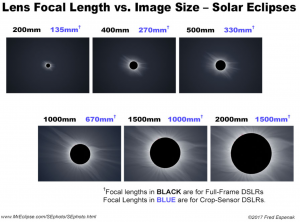
from: MrEclipse.com
I’m still on the fence if this would have made for more amazing photos: Opteka 650-1300mm (with 2x- 1300-2600mm) — The f-stop would be atrocious if there was any zooming at all, although it can be argued that going over 650mm is useless if you want to capture corona during the totality. The graphic from MrEclipse.com should be referenced for this debate in the future:
MrEclipse also has a great chart for recommended shutter speeds.
Overall, taking photos of the initial phases of the eclipse with the eclipse filter on was easy. Plenty of time, conditions not changing that much, very little to actually worry about preparing for. The totality time is what brings all the stress, regrets, and thoughts for next time.

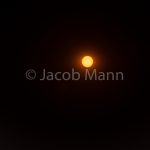
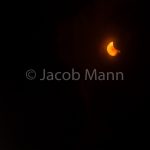
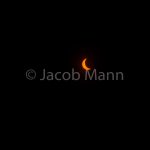
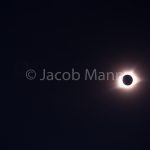
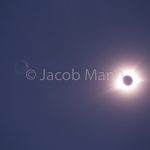
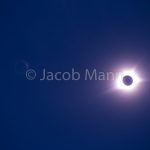
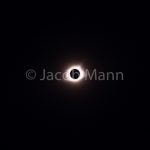
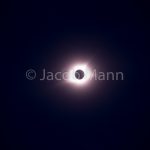

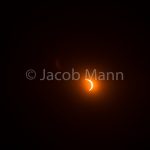
Really nice photos! Having the correct filter was definitely key to this. Congratulations!